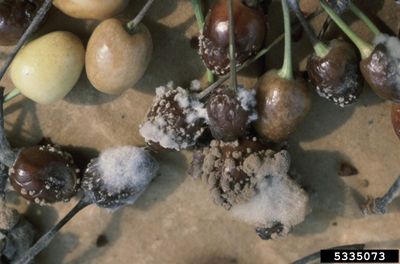Symptoms of Cherries with Brown Rot
The first symptoms of cherries with brown rot are browning of blossoms and small brown spots on ripening fruit, followed by death of small twigs. Infected blossoms often drop off the tree and gummy cankers appear on twigs between healthy and diseased areas. Fruit remaining on the tree may become mummified. The spores spread in damp weather, when you may see clumps powdery, brownish-gray spores on infected flowers and fruit.
Controlling Cherry Brown Rot Treatment
Here are some tips for the management of brown rot in cherry trees in the landscape: Sanitation: Pick up fallen fruit around the tree and rake all other plant debris to decrease the number of spores. Remove any mummified cherries that remain on the tree in early spring. Pruning: When pruning cherry trees in winter, remove any twigs that have died as a result of brown rot. Prune all branches with cankers. Fungicides: If signs of brown rot appear after sanitation and pruning, a fungicide may prevent infection. Brown rot in cherry trees must be sprayed with fungicides at two separate times, as follows:
Spray fungicides for brown rot in cherry trees when blossoms first begin to open. Repeat according to label recommendations until the petals drop. Spray the trees when fruit is ripening, generally two to three weeks before harvest. Repeat according to label recommendations until the fruit is harvested.
Use only fungicides labeled for the particular type of tree. Some products are safe to use on ornamental cherries but unsafe for edible cherries. Also, products registered for use on peaches or plums may not be safe or effective for controlling cherry brown rot. Fungicides for cherry brown rot treatment will be more effective if you continue proper sanitation and pruning. Note: Any recommendations pertaining to the use of chemicals are for informational purposes only. Chemical control should only be used as a last resort, as organic approaches are safer and more environmentally friendly
